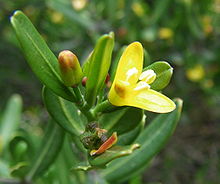Cneoraceae
Appearance

Cneoraceae is a Mediterranean relict shrub family that evolved under tropical conditions during the Cenozoic era. It is a dicot that generally favours higher altitudes and is rich in tannin. It produces both hermaphrodite and male flowers but the male flowers produce more fertile pollen, leading to a fruit.[1]
There are two genera and six species in tropical Africa, South and Southeast Asia, northern Australia, the Canary Islands, the northwestern Mediterranean, Cuba and China. The genera are Cneorum and Harrisonia.
The APG II and APG III systems have assigned these genera to the family Rutaceae.
References
- ^ Traveset, Anna (1995). "Reproductive ecology of Cneorum tricoccon L. (Cneoraceae) in the Balearic Islands". Botanical Journal of the Linnean Society. 117 (3): 221–232. doi:10.1006/bojl.1995.0014.
